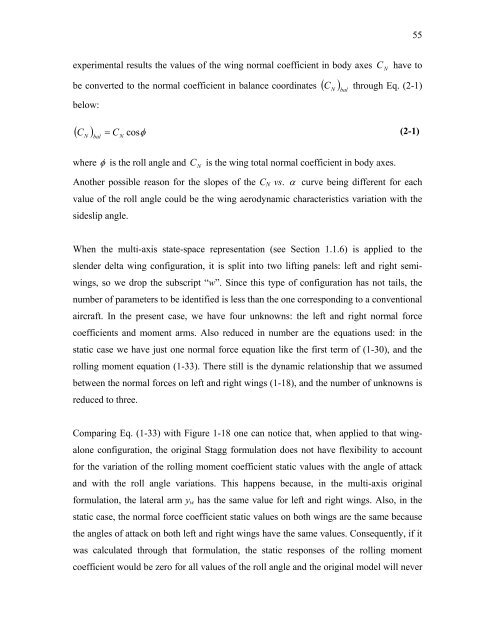Aircraft Stability Analysis Including Unsteady Aerodynamic Effects
Aircraft Stability Analysis Including Unsteady Aerodynamic Effects
Aircraft Stability Analysis Including Unsteady Aerodynamic Effects
You also want an ePaper? Increase the reach of your titles
YUMPU automatically turns print PDFs into web optimized ePapers that Google loves.
55experimental results the values of the wing normal coefficient in body axesC Nhave tobe converted to the normal coefficient in balance coordinates( C N) balthrough Eq. (2-1)below:( ) C cosφC = (2-1)NbalNwhere φ is the roll angle andC Nis the wing total normal coefficient in body axes.Another possible reason for the slopes of the C N vs. α curve being different for eachvalue of the roll angle could be the wing aerodynamic characteristics variation with thesideslip angle.When the multi-axis state-space representation (see Section 1.1.6) is applied to theslender delta wing configuration, it is split into two lifting panels: left and right semiwings,so we drop the subscript “w”. Since this type of configuration has not tails, thenumber of parameters to be identified is less than the one corresponding to a conventionalaircraft. In the present case, we have four unknowns: the left and right normal forcecoefficients and moment arms. Also reduced in number are the equations used: in thestatic case we have just one normal force equation like the first term of (1-30), and therolling moment equation (1-33). There still is the dynamic relationship that we assumedbetween the normal forces on left and right wings (1-18), and the number of unknowns isreduced to three.Comparing Eq. (1-33) with Figure 1-18 one can notice that, when applied to that wingaloneconfiguration, the original Stagg formulation does not have flexibility to accountfor the variation of the rolling moment coefficient static values with the angle of attackand with the roll angle variations. This happens because, in the multi-axis originalformulation, the lateral arm y w has the same value for left and right wings. Also, in thestatic case, the normal force coefficient static values on both wings are the same becausethe angles of attack on both left and right wings have the same values. Consequently, if itwas calculated through that formulation, the static responses of the rolling momentcoefficient would be zero for all values of the roll angle and the original model will never
















